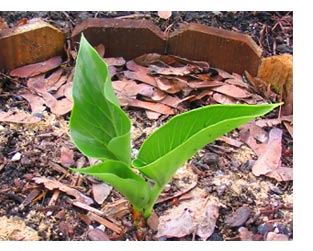The Cardiocrinum Project
More than anything, I must have flowers always, always --Claude Monet
 In July of 2004 I chanced upon a plant that I was both previously unaware of and taken totally by surprise by - Cardiocrinum giganteum. Even though it had completed flowering nearly a month earlier, the remaining stalk and seed pods had an imposing presence that simply could not be ignored. While obviously a lily, the 10 ft (3 meter) stalk and four inch long seed pods were certainly on a scale beyond anything I was familiar with.
In July of 2004 I chanced upon a plant that I was both previously unaware of and taken totally by surprise by - Cardiocrinum giganteum. Even though it had completed flowering nearly a month earlier, the remaining stalk and seed pods had an imposing presence that simply could not be ignored. While obviously a lily, the 10 ft (3 meter) stalk and four inch long seed pods were certainly on a scale beyond anything I was familiar with.
When I say I 'chanced upon' this plant I really do mean just that. I was on vacation in Victoria, BC, Canada visiting a small garden run by The Land Conservancy (TLC), a non-profit charitable land trust that works throughout British Columbia. This particular garden, the Abkhazi Garden at 1964 Fairfield Road in Victoria is an excellent example of their work. The plants - three or four of them - were in a wooded section of the garden and were completely unmarked. After a few minutes we tracked down the gardener. Her eyes lit up when we asked about the huge lily stalks. That was when we were introduced to Cardiocrinum giganteum.
Sometimes known as the giant Himalayan lily, it is a truly remarkable specimen when in bloom. From seed, the plant requires approximately 7 years to reach maturity and produce its first blooms. The 10 foot tall stalk (some sources suggest it can even grow to 15 feet!) bears up to 40 white, fragrant, trumpet shaped flowers (much like an easter lily with a dark purple throat) that are 8 to 14 inches in length (again, depending on your source.) Then comes the bad news. Once it blooms, the bulb dies. Fortunately it produces a small basket full of 'offsets' that can be planted and will produce blooms again in 3-5 years.
I quickly identified this item as a 'must have' for my own garden. Then began the search for a source - I managed to locate 5 year old bulbs for $60-$80 a piece from the UK, non of which were authorized to export to the US. Seeds are relatively abundant but with all sorts of negative stories about success in germination, some sources suggesting the seeds might not sprout for upwards of a year and a half. Then there's that 7 year waiting period. Truly, this is going to be a labor of some patience.
I finally identified a source of small bulbs - Forest Farm - in Williams, Oregon - again just a few miles from home! (See my Heather Garden for another 'close to home' plant source.) I purchased six bulbs to be distributed to my sister and parents to ensure we get to see at least one of them in full bloom. This will test the somewhat cooler and damper climate of the North Puget Sound, WA area, the greater climatic extremes of the east Cascade foothills near Hood River, OR, and the north Willamette Valley of Oregon.
So, watch this page as I try my hand at cultivating this truly unique specimen!
Sources of information on the cultivation of Cardiocrinum Giganteum:
The Cardio-journal